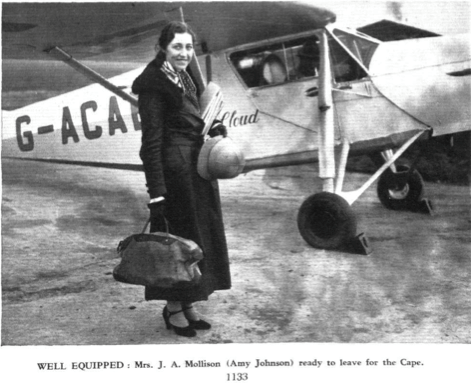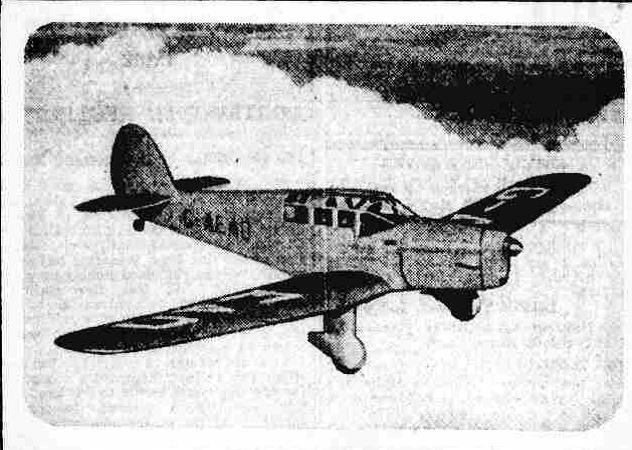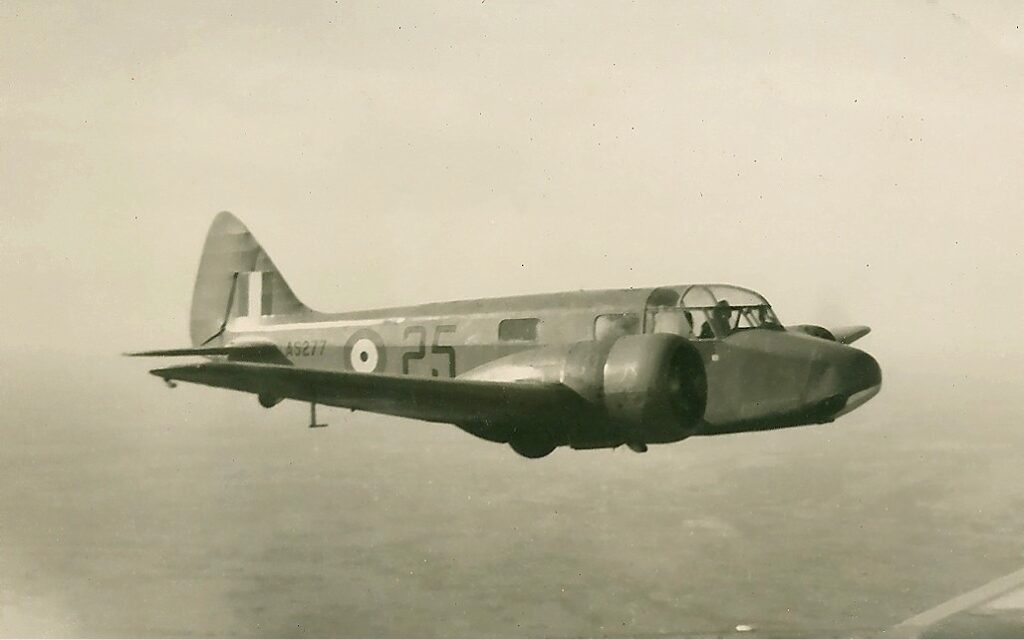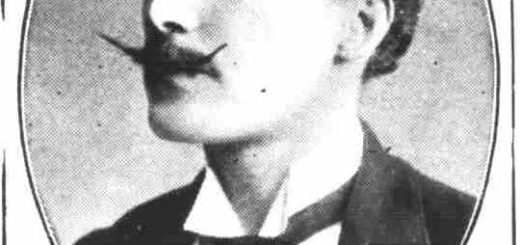AMY JOHNSON and BLACKPOOL
A brief sketch of Amy Johnson’s association with Blackpool, mostly taken from contemporary newspaper reports, with some added detail, and pics, from a brief online check. All sources acknowledged.
Amy Johnson was born and brought up in Hull. Though she had already courted Blackpool along with fellow aviators – and aviatrices, since women, as well as men featured in early flight – her special association with Blackpool, began when her married sister, Molly, moved to live on Newton Drive in the town with her husband, Trevor Jones, who had been appointed assistant town clerk in 1933 (and later, as Chief Town Clerk, to commit suicide in 1955). Amy’s association with Blackpool ended in 1941 when she left the town’s aerodrome to begin her final, fatal trip in her role in the Air Transport Auxiliary during WW2.
Educated, adventurous, determined and clever, her record-breaking flight to Australia in 1930 had brought her to the attention of the world, and she became a focus for the independence of women. The longest flight she had undertaken before her first epic flight, was to Hull and back from London to see her parents before she left. She had learnt to fly at Stag Lane aerodrome, N. London and had passed her mechanics certificates there.
In the early 1930’s, and after Amy’s fame had been permanently incused into the public consciousness, discussions, sometimes heated, were taking place in Blackpool in order to determine the principal site of the town’s municipal airport. The existing aerodrome at Stanley Park was considered too close to both the residential areas of the town and especially the land that the Council wanted to sell for the proposed new hospital. The other site was Squire’s Gate which had accommodated the first public air show in the UK in 1909. There were voices which opposed the provision of an airport at all, claiming that road and rail were sufficient to bring in the holiday makers into the town. Into this discussion the name of Amy Johnson was thrown. Such a celebrated name would be ideal to promote the benefits of an airport which would be ideally developed at Squires Gate rather than Stanley Park. However, the Stanley Park contingent won in the short term, and a hangar and club house were built. (The War soon arrived, the military took over the airport and after the War, Squires Gate became the municipal airport.)
In June 1931 Amy Johnson was in Blackpool as one of the pilots in the Blackpool Air Pageant which included several Schneider Cup ‘Aces’ and Winifred Brown, winner of the 1930 King’s Cup race. The pageant would include gliding and aerobatics as well as a non-stop race to London and back for which a gold cup and other prizes would be offered.
Later in the year she was back in Blackpool to give an audience at the Grand Theatre on her solo flight to Australia the previous year. Hundreds waited her arrival at Stanley park airport but had to be disappointed as she arrived ….. by train. There was a traffic hold up outside the entrance to the Theatre, but she managed to get in via the rear entrance. Not so lucky on the way out however, since she was spotted by the crowd which engulfed her in seconds and she had to be escorted away by the police to her reception at the Tower restaurant, a guest of the Tower and Winter Gardens Company. Her lecture, accompanied by lantern slides told of how she had planned her flight before she even had a plane to fly in, and how she had worked in London to save up for it. Her flight included many crashes and close escapes.
In 1932 she is recorded in Blackpool again, having to make an unscheduled landing at the town’s airport. On her way back to London from her honeymoon in Scotland, she had flown the length of the promenade to watch the holiday crowds when her Moth plane developed an engine fault. Knowing Blackpool well, she landed at the aerodrome, and was up and away again in five minutes. She was now Mrs Mollison having, on July 27th, married fellow aviator Jim Mollison, a Scotsman and playboy whose autobiography would be entitled ‘Playboy of the Air’. With this honest description of himself, it is not surprising that the marriage didn’t last and in 1937, the date of its publication, he asked Amy for a divorce, it being finalised in 1938.
Later in the year Amy was making plans to break the record for a flight from the Cape to England in a de-Havilland Puss Moth, eventually setting of in mid November, expecting to easily beat the record, and expecting to be back home for Christmas with her husband.
Her flying instructor and manager, William Courtenay, conducted the promotion of her solo adventures. He was also a pioneer aviator, soldier and RAF pilot, and he was in Blackpool with Alan Cobham’s Air Tour of Britain (when there was fatal mid-air collision in September 1935, in which two local sisters were killed and later buried at Marton cemetery.) He also gave lectures on his experiences of flying. My Dad, then at Palatine school, was one of several schoolchildren to have won a trip in Alan Cobham’s 10-seater passenger bi-plane, ‘Youth of Britain’. These trips, offered wherever the Air Tour took place, were sponsored by Sir Charles Wakefield, oil magnate of Castrol Oils, and presented as prizes in the local papers.
http://www.motorsportmagazine.com/archive/article/february-1993/62/air-other-courtenay

The de-Havilland Puss Moth, (‘Desert Cloud’) similar to the one in which Amy flew down from Scotland and made an emergency landing at Blackpool. Here, in 1932, Amy is ready to set off on her first Capetown challenge. The photograph is captioned Croydon, and is nicely posed. The starting point for her flight was actually Lympne air strip, much closer to the coast.
https://www.thisdayinaviation.com/tag/amy-johnson-cbe/

. The Daily Mail had sponsored Amy’s celebratory tour of the country, an exhausting obligation for her which resulted in exhaustion and emotional breakdown. (The Daily Mail cancelled her contract, which had some months to run, at no cost to her.)
In 1933 Jim Mollison, was staying in the town and opened Blackpool’s bowling tournament. At this time he also announced that he would go in search of the missing aviatrix Lady Bailey who had not been heard of for some time while flying solo. Jim Mollison’s passions in life appeared to be not only chasing women but also chasing whisky. He would be accompanied on the flight by William Courtenay and a mechanic. The plane for the search (a De-Havilland; Dragon Moth) donated by Edward Hillman, (pioneer of passenger air travel and who owned Hillman’s Airways (Wiki) and was waiting ready for them at Blackpool. Flying was for the rich and materially privileged ((but, without whom flying would not have progressed as fast).
In June 1933 Amy’s sister Mary (affectionately ‘Molly’) married Trevor Jones in Hull. Trevor Jones her husband, was working in local government in Hull (and also keen on aviation and travel) and, in February, had been appointed assistant town clerk in Blackpool. In 1937 he would be promoted to Town Clerk on the retirement due to ill health of the current Town Clerk, Mr D L Harbottle. 1933 Amy was admitted to Hospital in New York. She has flown the Atlantic with her husband Jim Mollison where their plane had crashed on landing. Trevor Treharne Jones would commit suicide in 1955, when allegations of corruption had surfaced within the Council.
In 1935 a headline in the Lancashire Evening Post reading, ‘Blackpool Official’s Crash Escape’ referred to a crash in which Amy was involved. She was the driver of a car which was in collision with a motorcycle, where the pillion passenger was killed. She was visiting her family in Bridlington and the crash occurred as she was travelling towards Hull in the company of her brother in law and her father. Trevor Jones, who was convalescing after an illness, is described as a good friend of Jim Mollison, who often visited Blackpool.
In 1936 Amy began a second record flight to Capetown in order get back her record form Tommy Rose who had broken her earlier record. She also intended to come straight back thus setting the record for a there and back flight.
Amy’s plane was a Percival Gull (monoplane) and coloured pale blue and grey. She set off from Gravesend at 5.30 am and there to see her off were her father, her sister Molly and husband, (the deputy Town Clerk of Blackpool), Blackpool Councillor Marshall and his wife, Mr and Mrs Courtenay, and Miss Winifred Irving and P G Reiss, and also the Daily Mail reporter.

The front page of the Daily Mail, (which had a vested interest in Amy Johnson), April 3rd 1936, as she stepped into the plane immediately before setting off.

In April 1938 Amy was in Blackpool addressing a convention of about 800 women at the Norbreck Hydro.

Mrs Trevor Jones in the picture is Amy’s sister. In her address to about 800 women of the North West and Wales Electrical Association she claimed not to be doing much flying but rather concentrating on, and enjoying, gliding. The Association was formed to give women a better understanding of electricity which was increasing in popularity and usage but not in understanding. Amy herself was a qualified mechanic.

1938 April 29th she is a competitor in a motor rally at Blackpool. She had taken to rallying and gliding and even to modelling clothes, less adventurous than breaking long distance flight records.
Amy Johnson’s name is on the ‘distinguished visitor’s book’ at the Town Hall in Blackpool, a town to which she paid many visits, attending dinners at the Blackpool Aero Club and was chief guest at the Squires Gate air display in 1935. She and her sister had made the trip to North Africa together by plane to visit the sight of her first crash landing on her trip to Capetown the first time around
On the evening of January 6th 1941, just after they had arrived back from watching Charlie Chaplin in the recently released ‘Great Dictator’, Mr and Mrs Jones received the news that their sister and sister in law respectively was missing, believed drowned, and there was little hope of finding her alive. She had been working for the Air Transport Auxiliary, ferrying aircraft and personnel between the various airstrips.
There are plenty of theories as to the cause of her crash into the Thames, the more confident one being that she was shot down by friendly fire in a mix up with an identifying signal. A plausible explanation, hushed up by the Ministry of Defence, since Amy was a clever, practical person who had already coped with anything that could be thrown at her on her long, solo journeys, and mistakes were not really in her repertoire. But the lack of an explanation remains, and the element of mystery persists without inviting conspiracy theories.
Airspeed Oxford (popularly referred to as the ‘Ox-box’) of the kind she was ferrying to an airport for the ATA.

1941 Stoker John Colbourn DSM of Lingfield Rd Fleetwood was on one of the ships that attempted the rescue of Amy from the freezing waters of the Thames. The plane, it is reported was found, but not the body.
Amy Johnson had a dance tune named after her. https://www.youtube.com/watch?v=8dsiZgRKh2k
1942 A film on the lives of Amy and Jim ‘They Flew Alone’ starring Anna Neagle and Robert Newton is released
1944 Aspects of her will. In her will, Amy had left all her trophies to her father whose address is given as Newton Drive Blackpool, the home of her sister Molly (Margaret). All her books went to her former school in Hull (the Boulevard) and two halves of the residue of over £2,000 to her two sisters.
Most information comes from the British Library newspaper archive via findmypast. Newspaper image © The British Library Board. All rights reserved. With thanks to The British Newspaper Archive (www.britishnewspaperarchive.co.uk).
Trevor Jones’ suicide is described at Martin O’Callaghan’s excellent crime series which invites you into Blackpool through its back door rather than through its glossy front door. https://blackpoolcrime.wordpress.com/tag/blackpool-trevor-jones/





Very nice article.
What was William Courtenay’s reaction to Amy Johnson’s death? Did he write an article? They had a close relationship, she was godmother to his son, Paul.
I’m writing a biopic about William Courtenay, I’m interested in finding out his reaction to Amy’s death.
Hi , thanks for your comment. William Courtenay’s autobiog, ‘Airman Friday’, was published before Amy’s death so there is no information forthcoming from there. I used this autobiog for my other post, https://www.cmronline.co.uk/the-flight-of-the-mailplane-blackpool-june-1932/ on William’s flight to Karachi. I’m not aware of his reaction to Amy’s death though I’m sure it was hard felt, so I can’t help there I’m afraid. Colin